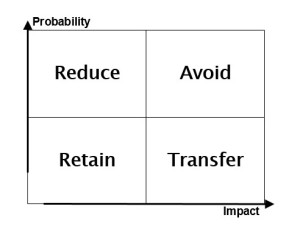
Construction in New Orleans
NEW ORLEANS — An evening photo of U.S. Army Corps of Engineers’ work on the T-Wall in St. Bernard Parish here. There are 115 cranes on this one job site. (Photo courtesy of the St. Bernard Polder) Taken March 2011
1. IDENTIFYING & ALLOCATING RISK
The following matrix is a common tool for analyzing risk based on its likelihood of affecting you and the severity of its impacts if it does affect you.
Events in the upper left quadrant are likely to happen but have low severity of impact – these carry risks that should be reduced.
Events in the upper right quadrant are likely to happen and have high severity of impact – these carry risks that should be avoided.
Events in the lower left quadrant are unlikely to happen and have low severity of impact – these carry risks that can be retained or accepted.
Events in the lower right quadrant are unlikely to happen but have low severity of impact – these carry risks that should be transferred or insured against.
For more on this topic, refer to the following material from “Enterprise and Individual Risk Management”:
(Reference: http://2012books.lardbucket.org/books/enterprise-and-individual-risk-management/s08-04-risk-management-alternatives-t.html)
All risks are rightfully the owner’s unless transferred or assumed by another party for fair compensation.
In transferring risk, the risk allocation process asks:
- What levels of risk are realistic to assume?
- Who best assumes each risk?
- What levels and kinds of risks are best passed on to insurance carriers?
Transferring Risk Through Insurance
Professional Liability Insurance for Architects and Engineers
https://www.irmi.com/articles/expert-commentary/professional-liability-insurance-for-construction-projects
Professional Liability Insurance for Construction Managers

Soldier Keeps Watch During Construction of Route Trident in Helmand, Afghanistan
A member of 9 Parachute Squadron 23 Engineer Regiment keeps watch during the construction of the next phase of Route Trident in Helmand, Afghanistan. A digger is pictured moving the foundations of the road in the background.
This particular phase of the major road building project has seen the engineers tackle a challenging piece of terrain known as the “Culvert of Doom” close to the Patrol base at Nahidullah.
The road is being solidly constructed using carpet-like membranes, tough plastic neo cells and high quality aggregates and stone, which should hold together well despite heavy vehicles and harsh weather conditions.
Local people themselves are being employed to carry out some of the work which brings welcome cash into the area’s economy. The route itself will enable trade and commerce for many years to come.
The engineers have heavily committed to an operation to build across the Loy Mandeh. In the clear phase, the combat engineers provided explosive breaching to enable 2 Scots to break into insurgent strongholds. Holding work included the reinforcing of compounds, and the construction of Sangers.
Route Trident is now being extended across the Mandeh. The terrain is harsh and challenging; requiring plenty of airborne initiative.
via UK Ministry of Defence
2. RISK & CONSTRUCTION
Primary risks to construction projects include disruptions to design performance, budget, and schedule. These disruptions occur for a variety of reasons including:
- The scope is not well-defined at the outset
- The contractor under-performs
- During the project, the owner interferes with:
- The scope
- The management, etc.
- Unforeseen events
Risks affect all parties / stakeholders on a project.
Owners: that they embark upon or frame a development uninformed of some of the risks involved
Contractors: that they adopt risk that they do not understand and lose money, perhaps becoming bankrupt, thus reducing the global pool of contractors capable of doing work
Both parties: that if the risk is poorly understood and allocated, it is likely to be incorrectly assessed, mitigated, insured and managed, resulting in poor project delivery
Those further down the supply chain: that if the two main players cannot deal with risks well themselves, sub-contractors are likely to manage this poorly too
Those outside (such as banks, national oil companies, etc.): that they will take poorly informed decisions that make the risk environment worse
All parties: in that a lack of understanding of risk leads to inefficiency where each pays more and makes less out of the venture – IMCA
The handling of risk in construction contracts varies considerably. Depending on:
- The nature and location of the work
- The operator and contractor involved
- The prevailing contracting climate
- Also outside influences such as banks, governments and the insurance market.
Each of these varies over time. The International Marine Contractor’s Association offers the following understatement:
In recent years, operators and contractors have remarked that the balance and handling of risks in some contracts was not ideal. – IMCA

Construction Barges
Bridge construction, concrete/foundation construction: Two transportable compartment barges provide working platform for heavy equipment constructing foundation and structure for concrete bridge. Far barge supports Genie hydraulic telescoping boom man lift/ work platform. Near barge supports Terex HC80 crawler based open web truss boom cable crane. Barges are anchored by piles driven shallow distance into river bed. Dixboro Road Bridge over Huron River, Ann Arbor, Michigan 2005.
via Robert Carr
3. RISK MITIGATION
Risk mitigation requires that you:
- Minimize risks
- Share risks equitably
Plan for the worst – in advance.
Plan for your site.
Plan for your business operations: Are you disaster ready – ENR – Jeff Cavignac – April 4, 2013
Escalation Clauses – After winning a lump sum bid, material prices may go up. Who assumes that risk? http://www.constructionlawmonitor.com/2010/03/who-assumes-the-risk-of-material-cost-increases/
4. DISPUTE RESOLUTION (MORE THAN GOING TO COURT)
Mediation, Arbitration, and Litigation
Litigation is hugely expensive, time consuming and emotionally draining. Although litigation has its place, in most cases it is an ineffective way to resolve business disputes. In fact, 19 out of 20 litigated cases are not decided by a judge or jury, they are resolved prior to final adjudication.
Litigation and arbitration are considered adversarial. There is a winner and a loser and often times the process will destroy business relationships. Unlike litigation and arbitration where a third party will decide who is right and who is wrong, the mediator’s job is to work with both parties so they can come to resolution. It is also important to recognize that if mediation doesn’t work out, the parties have the option of either arbitration or litigation. via Cavignac, 2013.
Read more about this topic:
Alternate Dispute Resolution _ ENR_ Engineering News Record _ McGraw-Hill Construction. 2013. Jeff Cavignac.




